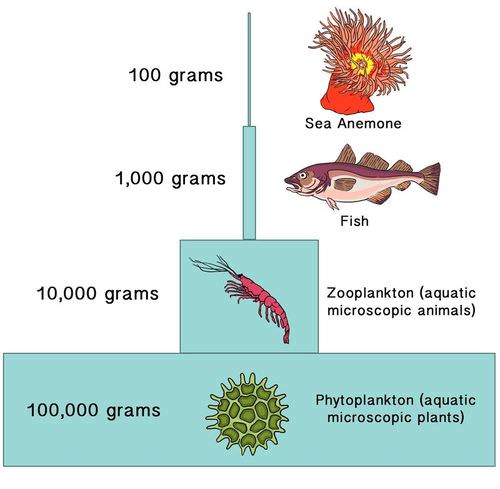12.19 能源流动
章节大纲
-
How much energy could be gained from the gazelle?
::从羚羊身上可以获取多少能量?If the cheetah is successful in capturing the gazelle, it would gain some energy by eating it. But would the cheetah gain as much energy as the gazelle has ever consumed? No, the gazelle has used up some of the energy it has consumed for its own needs. The cheetah will only gain a fraction of the energy that the gazelle has consumed throughout its lifetime.
::如果猎豹成功地捕捉了羚羊,它就会通过食用它而获得一些能量。但猎豹的能量会和羚羊所消耗的一样多吗?不,鹦鹉已经消耗了它所消耗的部分能量来满足自己的需要。猎豹只获得它一生所消耗的能量的一小部分。Energy Pyramids
::能源金字塔When an herbivore eats a plant, the energy in the plant tissues is used by the herbivore. But how much of that energy is transferred to the herbivore? Remember that plants are , bringing the energy into the by converting sunlight into glucose . Does the plant use some of the energy for its own needs? Recall the energy is the ability to do work, and the plant has plenty of "work" to do. So of course it needs and uses energy. It converts the glucose it makes into ATP through just like other organisms . After the plant uses the energy from glucose for its own needs, the excess energy is available to the organism that eats the plant.
::当草食动物食用植物时,植物组织中的能量是用在草食动物身上的。但有多少能量被转移到草食动物身上? 记住植物是,通过将阳光转换成葡萄糖,将能量带入植物。植物是否将一些能量用于自己的需要? 想想能量是工作的能力,植物有充足的“工作”做。因此,植物需要并使用能量。它通过其他生物将葡萄糖转化成ATP。植物用葡萄糖的能量满足自己的需要后,超量能量可以提供给食用植物的有机体。The herbivore uses the energy from the plant to power its own life processes and to build more body tissues. However, only about 10% of the total energy from the plant gets stored in the herbivore’s body as extra body tissue. The rest of the energy is used by the herbivore and released as heat. The next consumer on the that eats the herbivore will only store about 10% of the total energy from the herbivore in its own body. This means the carnivore will store only about 1% of the total energy that was originally in the plant. In other words, only about 10% of energy of one step in a food chain is stored in the next step in the food chain. The majority of the energy is used by the organism or released to the environment.
::草食动物用植物的能量来给自己的生命过程提供动力,并建造更多的人体组织。然而,只有大约10%的植物总能量储存在草食动物的身体中,作为额外的人体组织。其余的能量由草食动物使用,作为热量释放。下一个食草动物的消费者只能将10%的总能量储存在自己的体内。这意味着肉食动物只储存原在植物中的全部能量的1 % 。 换句话说,只有大约10%的食物链中一步的能量储存在食物链的下一步。 大部分的能量由有机体使用或释放到环境中。Every time energy is transferred from one organism to another, there is a loss of energy. This loss of energy can be shown in an energy pyramid . An example of an energy pyramid is pictured below ( Figure ). Since there is energy loss at each step in a food chain, it takes many producers to support just a few carnivores in a community.
::每当能源从一个有机体转移到另一个有机体,能源就会损失。这种能源损失可以在一个能源金字塔中显示出来。一个能源金字塔的例子在下面(图 ) 。 由于在食物链的每一步都会发生能源损失,因此许多生产者需要支持社区中仅有的几个食肉动物。Each step of the food chain in the energy pyramid is called a trophic level . Plants or other photosynthetic organisms ( autotrophs ) are found on the first trophic level, at the bottom of the pyramid. The next level will be the herbivores, and then the carnivores that eat the herbivores. The energy pyramid ( Figure ) shows four levels of a food chain, from producers to carnivores. Because of the high rate of energy loss in food chains, there are usually only 4 or 5 trophic levels in the food chain or energy pyramid. There just is not enough energy to support any additional trophic levels. Heterotrophs are found in all levels of an energy pyramid other than the first level.
::能源金字塔中食物链的每一步都被称为营养级,植物或其他光合生物(自养生物)在第一个营养级,即金字塔底部发现,下一个层次是食草动物,然后是食食食食食食食食食食食食食肉动物。能源金字塔(图)显示食物链的四个层次,从生产者到食食动物。由于食物链中的能源损失率很高,食物链或能源金字塔中通常只有4到5个营养级。仅仅没有足够的能量支持任何额外的营养级。除一级外,能源金字塔的所有层次都发现了血化营养。As illustrated by this ecological pyramid, it takes a lot of phytoplankton to support the carnivores of the oceans. This energy pyramid has four trophic levels, which signify the organisms place in the food chain from the original source of energy.
::正如这个生态金字塔所说明的,需要大量的浮游植物来支撑海洋的食肉动物。 这个能源金字塔有四个营养级,这表示生物在食物链中的位置来自原始的能源来源。Summary
::摘要-
As energy is transferred along a food chain, energy is lost as heat.
::随着能源沿食物链转移,能源随着热量而丧失。 -
Only about 10% of energy of one step in a food chain is stored in the next step in the food chain.
::食物链中一步的能量中只有大约10%储存在食物链的下一步。
Explore More
::探索更多Use the resource below to answer the questions that follow.
::利用以下资源回答以下问题。-
Ecological Pyramids
at
(4:03)
::生态金字塔(4:03)
-
What are three types of ecological pyramids? How do their shapes compare?
::什么是三种生态金字塔?它们的形状如何比较? -
Do you think it would be possible to construct a pyramid where the number of carnivores was more than the number of herbivores? Why or why not?
::你认为可以建一个金字塔吗? 食肉动物的数量超过食草动物的数量? 为什么不行? -
Do you think it would be possible to construct a pyramid where the biomass of carnivores was more than the biomass of herbivores? How does this compare to a numbers pyramid.
::你认为可以建一个金字塔 肉食动物的生物量 超过食草动物的生物量吗?这跟数字金字塔有什么比? -
What consumes energy at each trophic level? How does this contribute to energy loss between trophic levels?
::每个营养级消耗能源的是什么?这如何造成营养级之间的能源损失?
Review
::回顾-
When an herbivore eats a plant, what happens to 90% of the energy obtained from that plant?
::当食草动物吃植物时 90%的植物能量会怎么样? -
What is a trophic level?
::什么是营养级? -
Why are the number of trophic levels limited?
::为什么营养级的数量有限? -
In a forest community, caterpillars eat leaves, and birds eat caterpillars. Draw an energy pyramid using this information.
::在森林社区,毛虫吃叶子,鸟吃毛虫。利用这些信息绘制一个能源金字塔。
-
As energy is transferred along a food chain, energy is lost as heat.

